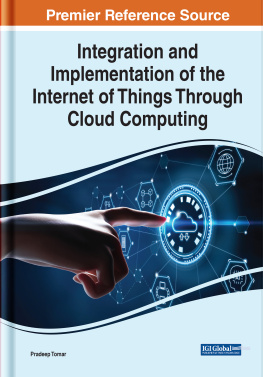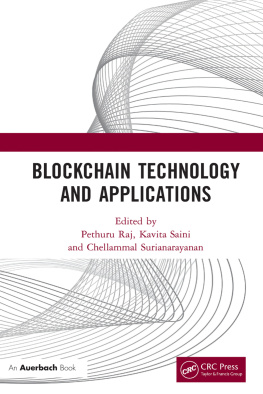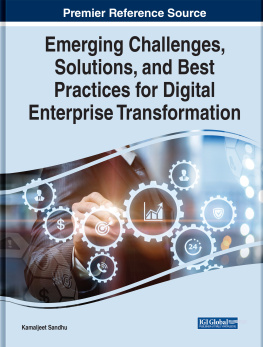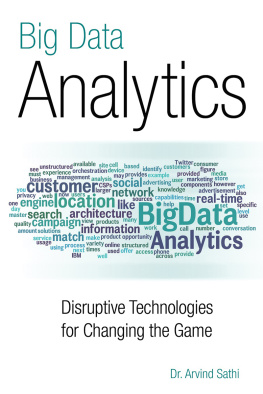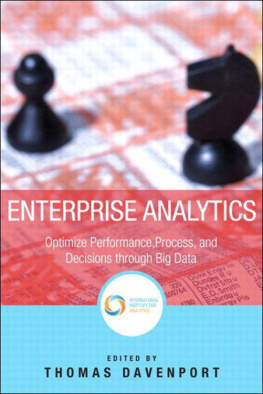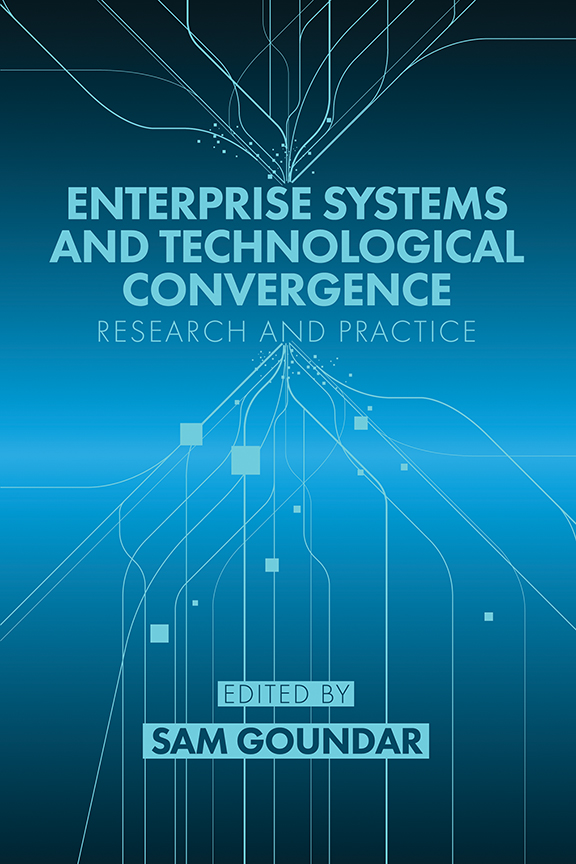______________________________________________
Enterprise Systems and Technological Convergence
_____
Copyright 2021. Information Age Publishing. All rights reserved. May not be reproduced in any form without permission from the publisher, except fair uses permitted under U.S. or applicable copyright law.
EBSCO Publishing : eBook Collection (EBSCOhost) - printed on 9/17/2021 2:55 AM via STRAYER UNIVERSITY
AN: 2730604 ; Sam Goundar.; Enterprise Systems and Technological Convergence: Research and Practice
Account: strayer
_____________________________________________
Enterprise Systems and Technological Convergence
Research and Practice
_____
edited by
Sam Goundar
The University of the South Pacific, Fiji
INFORMATION AGE PUBLISHING, INC.
Charlotte, NC www.infoagepub.com
EBSCOhost - printed on 9/17/2021 2:55 AM via STRAYER UNIVERSITY. All use subject to https://www.ebsco.com/terms-of-use
Library of Congress Cataloging-in-Publication Data
A CIP record for this book is available from the Library of Congress
http://www.loc.gov
ISBN: 978-1-64802-341-5 (Paperback)
978-1-64802-342-2 (Hardcover)
978-1-64802-343-9 (E-Book)
Copyright 2021 Information Age Publishing Inc.
All rights reserved. No part of this publication may be reproduced, stored in a
retrieval system, or transmitted, in any form or by any means, electronic, mechanical,
photocopying, microfilming, recording or otherwise, without written permission
from the publisher.
Printed in the United States of America
EBSCOhost - printed on 9/17/2021 2:55 AM via STRAYER UNIVERSITY. All use subject to https://www.ebsco.com/terms-of-use
Chapter 1
Introduction to Enterprise Systems and Technological Convergence
Sam Goundar
The University of the South Pacific
Enterprise systems, namely enterprise resource planning (ERP), have existed for decades and enabled organizations to gain a competitive advantage while integrating their functions and streamlining their operations. Over the years, enterprise systems have evolved with developments in technology and new ways of doing business. Technologies like cloud computing, in particular, have made access to enterprise systems ubiquitous. Such technologies were needed to cater for new business models like e-commerce that resulted in a different business environment. This rapid acceleration of technological diffusion has changed the way we work, do business, and live. The business and research community took this interplay of work, technology, and peoples into serious consideration which generated many researches and publications on socio-technical systems. The current enterprise systems that we have are results of these research and development efforts.
Todays fourth industrial revolution (4IR) is building on the third (the digital revolution), and future work is all about automation, machine learning, and artificial intelligence. The first industrial revolution introduced mechanization, which saved us from mundane tasks such as fetching water from the well and collecting firewood. The second industrial revolution used electrification to power factories into mass production and its products again assisted us for washing clothes, keeping our drinks cold, and heating our food. The third industrial revolution was about information communications technology to automate office work and business processes. However, we were still required to start the computers, run the programs, check the results, monitor processes, and take corrective action. With the fourth industrial revolution, the intention is to completely automate, let machines handle everything, and totally free ourselves.
In terms of technology, we initially started off by doing our own developments and isolating ourselves from others because we were out to compete, and taking market share as the bottom line was vital. For example, we started off with different and incompatible computer hardware in the form of distinct models where work done on one computer could not be used on another. Then, we went through the platform wars of Microsoft vs. Apple vs. Linux, and so on. And the same is being witnessed in the mobile platforms with Apple and Android. However, we have come to our senses and realized it is more profitable to become compatible, interoperable, and converge. Technologies have converged, likewise. Every existing and new technology needs to be able to converge with others for survival. The Internet became the platform for technological convergence and a one-stop shop to find anything and everything.
Your smartphone is an ideal example of technical convergence. Initially, with a phone, you could only make voice phone calls. Now, with a smartphone, not only can you make a voice phone call, you can also text, email, take photos, record videos, listen to music, make payments, get a ride, do banking, order food, browse the Internet, and the list is endless. Just imagine how many different technologies have converged into your smartphone: phone (voice call), camera (take photos), walkman (listen to music), video recorder (record videos), computer (email, browse, etc.), and the list of technologies that have converged into your smartphone goes on. Similarly, a number of technologies have converged with enterprise systems. For example, blockchains and smart contracts can now be used to converge different supply chains of all the stakeholders of a particular product, ensure transparency and build trust with customers and each other.
Organizations now operate in a global environment, are driven by technology, and need to contend with all demographics. These organizations collect data (very large amounts of databig data), deal with and process information (information overload) to make decisions. These organizations are now looking for enterprise systems that are smart, intelligent, and capable of analyzing and making fast decisions with big data to be able to survive in a global economy and fickle customers.
Enterprise Systems
The evolution of enterprise systems started during the early 1990s after decades of using silo-based information systems within business organizations. Enterprise systems, like ERP, is a software-based system that is responsible for making information, reporting, and functions widely available and centrally located within business organizations. ERP systems are comprehensive applications that support and connect all aspects of an organizations business processes. Business processes, such as departments of accounting, human resources, marketing, purchasing, manufacturing, and so forth, are all integrated into one system that shares a common database. This common database enables all departments and functions to share and access real-time information about the organization. ERP systems appeared in the 1990s as a way to provide accessibility, flexibility, and consistency across all the major business functions, unlike its predecessors. Organizations that use ERP systems have a better chance of being sustainable in an ever-changing business environment.
According to Motiwalla and Thompson (2012), the five important components have to work together in order to create an ERP system. These components are hardware, software, information, processes, and people. Hardware consists of the physical equipment such as servers and peripherals. Software is the operating system and/or database that the company or specific department uses. Examples of software today are Windows 10 or Linux. The information component is basically the data that is input to the system by internal or external organizational resources. Processes consist of policies and procedures that create the ways of conducting their business. The people of an ERP system are the end-users and IT staff. End-users can be anyone from the employees to the suppliers of a company. Just like homes and large-scale buildings, ERP systems have an architecture that the implementers must follow. Most of the time, a vendor is the one who creates the ERP architecture when an organization wishes to purchase outside the company (Motiwalla & Thompson, 2012).




